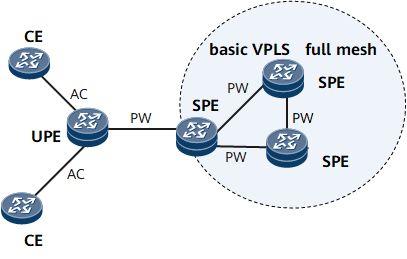Configuring LDP HVPLS
Before configuring LDP HVPLS, familiarize yourself with the usage scenario and complete the pre-configuration tasks.
Usage Scenario
On a typical VPLS network, all PEs are fully meshed. In this case, when a PE is added to the network, certain PEs are re-designated and PWs increase exponentially. As a result, system resources are greatly consumed and system performance deteriorates, limiting VPLS networking deployment and applications.
The core of hierarchical virtual private LAN service (HVPLS) is to hierarchize the VPLS network. You can fully mesh SPEs to connect multiple HVPLS networks. In this manner, multiple isolated HVPLS networks are interconnected without requiring a large number of full-mesh PWs. This configuration improves the scalability, deployability, and flexibility of VPLS networks. In addition, broadcast packets are decreased because full-mesh connections are decreased, improving entire network performance.

Pre-configuration Tasks
Before configuring LDP HVPLS, complete the following tasks:
Configure LSR IDs and enable MPLS and MPLS LDP both globally and per interface on the UPE, SPEs, and Ps.
Enable MPLS L2VPN on the UPE and SPEs.
Set up tunnels between the UPE and an SPE and between SPEs for data transmission.

Configure a remote LDP session if the UPE and SPE or SPEs are not directly connected.
- Configuring VPLS Between an SPE and a UPE
- A Switching provider edge (SPE) and an underlayer provider edge (UPE) set up a spoke PW, which does not comply with the split horizon principle.
- Configuring VPLS Between SPEs
- The VPLS configuration between SPEs is the same as the configuration of ordinary VPLS.
- (Optional) Changing the MAC Address Update Speed on an HVPLS Network
- The VPLS function between SPEs is similar to a common VPLS function.
- Verifying the LDP HVPLS Configuration
- After configuring LDP HVPLS, check information about VSIs, remote VSIs, VPLS connections, outbound interfaces of VSI PWs, and tunnel policies applied to VSIs.